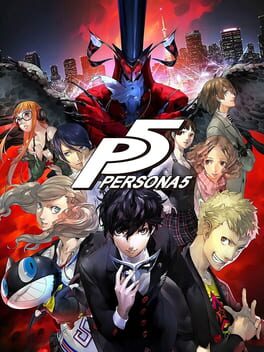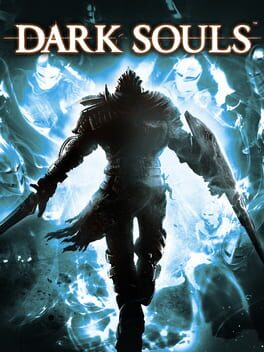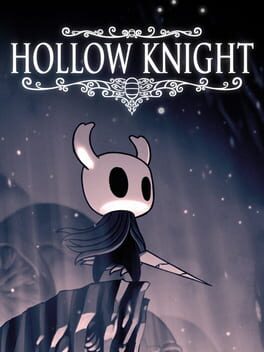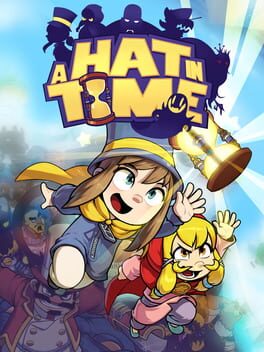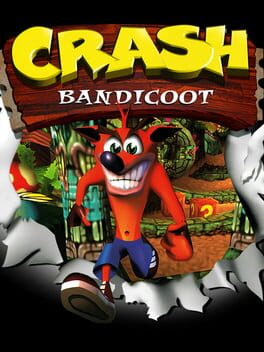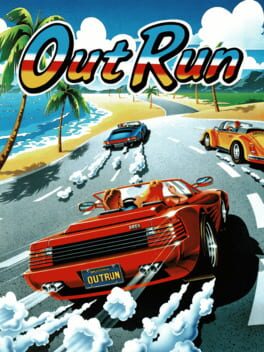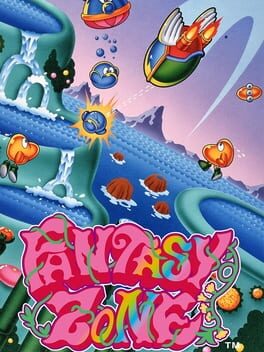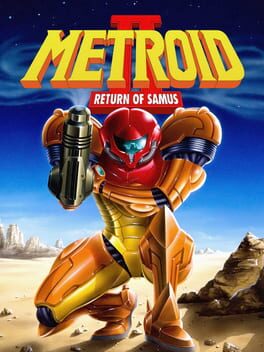Erockthestrange
Bio
Nothing here!
Badges

Listed
Created 10+ public lists

Donor
Liked 50+ reviews / lists

Adored
Gained 300+ total review likes

Loved
Gained 100+ total review likes

Popular
Gained 15+ followers

Well Written
Gained 10+ likes on a single review

Gone Gold
Received 5+ likes on a review while featured on the front page

Liked
Gained 10+ total review likes

Best Friends
Become mutual friends with at least 3 others

Noticed
Gained 3+ followers

Elite Gamer
Played 500+ games

Busy Day
Journaled 5+ games in a single day

3 Years of Service
Being part of the Backloggd community for 3 years

Gamer
Played 250+ games

N00b
Played 100+ games
Favorite Games
592
Total Games Played
025
Played in 2024
000
Games Backloggd
Recently Played See More
Recently Reviewed See More
One of the reasons why Sony trounced the once indomitable Nintendo in the console wars from their first attempt is because the PlayStation did not alienate any prospective demographics. As dedicated to their seal of quality standard as Nintendo was and still is, they admittedly get slapped with the stigma of a kiddy company akin to Disney. Because the third dimension allowed video games to depict graphic violence beyond what pixels were ever capable of, Sony capitalized on this market for mature video games when Nintendo was forced to stick to their family-friendly brand. Between the outstanding success of new IPs aimed at adults like Resident Evil and Metal Gear Solid, however, Sony still had to drum up a few franchises that appealed to a younger audience because that vital demographic would’ve easily stuck with their Nintendo standby that offered that kind of accessible content in spades. Sony released a plethora of new age-appropriate IPs to cover their marketing blindspot, but it’s difficult to say if any of these charming, cartoonish characters ever served as their definitive mascot like Mario for Nintendo. Sony learned from Sega’s example not to bet all of their money on sending their finest soldier into battle with Nintendo, for Sonic stumbled and bled out contending with far more than just Mario in Nintendo’s battalion. Even though Sony wisely treated their library as a collective, the closest character that could technically constitute a mascot for the system was Crash Bandicoot: the first of the PlayStation’s properties that was cut from the same platformer cloth that Mario laid out. The Crash Bandicoot trilogy on Sony’s first home console is fondly remembered by the younger demographic of gamers at the time, so Sony must have succeeded in converting at least a sizable fraction of Nintendo’s child consumer base to their console. Still, similarly to Sonic, Crash Bandicoot alone couldn’t have sucked Nintendo dry and stolen the video game console industry for themselves because the first Crash Bandicoot exemplified the roughest qualities of the early 3D era.
Since Crash Bandicoot was devised as a direct competitor with Mario and Sonic, let us examine his mascot material as thoroughly as a judge at a dog show. Upon lifting up and inspecting Crash Bandicoot’s proverbial undercarriage, I find that he’s as exemplary of a mascot breed as his older, iconic adversaries. For those of you who are neither zoologists or are native to Australia, a bandicoot is not a fictional animal like an Ewok or a mogwai. A bandicoot is a real strand of marsupial located down under the equator, even if this particular one was created in a laboratory by a mad scientist. Hence, why Crash has an unnaturally orange skin complexion like a clementine. Bandicoots are also not known to stand upright wearing jeans or sneakers either, but any additional human trinkets applied to Crash’s anthropomorphism aid his mascot stature. Actually, if there is one credit to Crash’s effectiveness as a mascot, it’s that he seems far more human than the representatives for Nintendo and Sega. Obviously, Mario is technically the only human in this equation, but I mean human in the sense of player-character relatability. If Mario is the charming, cherubically whimsical tramp of Chaplin, Sonic the daring thrill-seeker of Keaton, Crash is the blue-collar, exceptionally unexceptional everyman of Harold Lloyd, the uniformly third-place contender among the three comedy legends of the silent film era. Essentially, Crash better embodies the awkward and infallible personhood of a human being. If the fact that Crash doesn’t wear a shirt in his would-be-snappy combination of clothes is any indication, he isn’t afraid of conducting himself in an undignified manner. Once an enemy slights Crash on the field, he dramatically commits to the role by spinning around and uttering his trademark, high-pitched “whoa!” like the fun uncle after being “shot” by their nieces and nephews with a toy gun. Whenever Crash is flattened, eaten, burned, or electrocuted, the humiliation of the death animations is far more lively and detailed than what the exalted Mario and Sonic would allow. Crash blowing himself to bits upon hitting a TNT barrel and seeing nothing but his shoes and eyeballs rain down from the wreckage always tickles me. The whacky, silly tone emanating from Crash Bandicoot’s protagonist and overall presentation will also remind players that Crash Bandicoot, unlike Mario and Sonic, is distinctly American. Santa Monica-based developer Naughty Dog most likely grew up with Warner Bros. iconic Looney Tunes properties and implemented their cartoonish hijinks into their creation to give it a Western flavor of childish lightheartedness. Also, Crash’s spin move where he flails his body like a cyclone is too similar to the idiosyncratic swirling vortex of another Australian animal of the Looney Tunes canon to be a coincidence.
Beyond the tonal influences and the strive to compete with the big boys representing other companies, Crash Bandicoot practically functions as a 3D adaptation of Donkey Kong Country. No, really, the similarities between Crash Bandicoot and Rare’s rendering of another one of Nintendo’s finest platformer series is so uncanny that I’m convinced that Sony sent an undercover spy to the Rare offices to gather information on the development of Donkey Kong 64’s beta testing. For starters, Crash gains extra lives by gathering a hundred of his favorite kinds of fruit, the fictional apple and tangerine hybrid “wumpa fruit” in this instance instead of bananas. Crash’s movement in the overworld map is strictly limited to the narrow trajectory paved for him after completing a level, and the entirety of Crash’s journey takes place across three separate islands. As Crash diverts further from the shores of N. Sanity Beach and the wild, unkempt jungles that surrounded it and the other areas situated on the starting island, the settings will progressively become more tailored towards resembling human civilization. Ancient ruins in the jungle catacombs are one thing, but the areas of the third island encompass the quasi-gothic architecture of Cortex’s laboratory castle at the same pace as when the first DKC gradually became industrialized. Crash even has a disturbingly buxom bandicoot girlfriend that could substitute for Pamela Anderson in a furry version of Baywatch. Unlike her DKC counterpart Candy Kong, she’s the typical damsel in distress instead of a supportive checkpoint aid. Crash Bandicoot is evidently more man than animal compared to Nintendo’s burly, tie-wearing ape, and would probably trade all the wumpa fruit in the world for another knock at Tawna’s boots.
If all of the contextual evidence here doesn’t blast Donkey Kong Country in your face like stepping on a rake, then you obviously have never even glanced at the series from a distance much less played it. Rare probably had to scrap the production of Donkey Kong 64 upon seeing Crash Bandicoot and were forced to reshape it as the collectathon 3D platformer that we all know and harbor mixed feelings towards. Besides Crash existing as another animal outside of the primate family, the game offers plenty of admirably distinctive attributes that keep Nintendo from imposing on the rightful grounds of suing Sony’s asses off. Health in Donkey Kong Country was displayed abstractly using either Donkey Kong or Diddy Kong as a meat shield depending on who was stationed in front, losing the line leader Kong as a penalty for taking damage until the player came across a barrel with the grazed Kong freshly intact. Crash doesn’t tag team with a buddy that shares an equal precedence in terms of gameplay, but a series secondary character still shows up to block the barrage of blows from enemies. When Crash cracks open a crate with the image of a mystical, yet strangely friendly-looking mask on it, the crude illustration comes to life and bursts out of its confinement to levitate above Crash’s shoulder. Aku-Aku, the trust-worthy witch doctor mask, will not only save Crash’s bacon if he mistakenly brushes up too close to an enemy without executing the proper offensive maneuvers but breaking open other crates with Aku-Aku still hovering overhead will stack the number of defensive capabilities. By the third chain of Aku-Aku collecting, Crash will wear Aku-Aku on his face and storm the level with a hyperdrive state of invulnerability for around twenty seconds. Aku-Aku’s implementation is admittedly a variation on a health system that DKC already established, but the gratification of earning the invincibility streak as a reward for skillfully dodging obstacles is something that DKC never provided. Ultimately, other instances of Crash Bandicoot’s innovation on its influences lie in its design in the third dimension. With this polygonal advancement, branching paths seen in “N. Sanity Beach” and “Cortex Power” are visibly defined and are more lucidly chosen by the player as opposed to Sonic’s wonky rollercoaster levels. There’s a reason why Crash sprinting away from a boulder in an homage to Raiders of the Lost Ark in “Boulder Dash” is the most indelible image associated with the series, for the perspective of the action running towards the screen as Crash anticipates where to jump and evade at the first reflex, is truly a milestone for the 3D platformer genre.
Another familiar reminder of DKC conjured up in Crash Bandicoot is the brutally swift and consistent difficulty curve. Throughout the game, the player will be wishing for the loud whistle blow of a referee to call in their favor for the same fatal, recurring errors that befall anyone who has played a DKC game. However, all the mismatched mistakes suffered in DKC occur even more frequently in Crash Bandicoot because of the injection of the third dimension into the gameplay. I’d be dead if I decided to make a drinking game revolving around how many times one of Crash’s jumps reverted him off to the side of a platform because of that extra spatial dimension. Euclidean range is not your friend in Crash Bandicoot, but the player is forced to work around it and press their luck because the levels seen from Crash’s side view are more commonplace than proper 3D levels where the camera is pointed at his backside. It doesn’t help matters that Crash seems to execute his jumps stiffly because of the controls, feeling as if his bones are brittle on top of lacking a sense of confidence in his platforming abilities. Which level in the game draws out the most fury and contempt from players? Is it the lack of friction in the rainy tower ascent of the aptly named “Slippery Climb?” Perhaps the endurance test of Sunset Vista, or the array of scorchingly hot pipes in “Heavy Machinery?” For my money, it’s the rickety, broken bridge of “The High Road” that tested my patience the most with the exacting precision found in the game. But really, the worst aspect of continual death in Crash Bandicoot is that the game’s method of accommodating it is equally persnickety. The only way to save the game and plant a firm checkpoint on one’s progress is to complete a minigame unlocked by collecting three tokens with a character’s face on them found in each level. The issue with this stipulation is that it isn't guaranteed that the player will succeed in getting to the end of these sections, especially since a narrow bar of steel boxes suspended in the air is the only ground Crash has to walk upon. If the player fails to meet this standard, exhausting every life will drop them all the way back to the beginning of the game. Making the player earn what should be a requisite feature through a challenge outside of the primary objective isn’t any less cruel than simply not offering any continues in the first place.
Again, the DKC connections grow starker regarding Crash Bandicoot’s boss battles. If there is any aspect to the first DKC game that is brazenly half-assed, it’s a collective of tepid and uninspired boss battles that should’ve served as mighty climaxes to their slew of levels preceding them. Conquering Crash Bandicoot’s baddies proves to be just as effortless, but I’d be hard-pressed to label them as uninspired. Occasionally situated between the platforming levels on the map are the boss encounters to alternate the pace of gameplay. Like all of Bugs Bunny’s opponents in his disproportionate battle of wits, Crash’s enemies are an eclectic batch of animals with distinguished personalities. There’s the portly tribesman Papu Papu, the vain, steroid-freak Koala Kong, Tommy Gun-toting, Al Capone wannabe Pinstripe Potoroo, and the straight jacket-detained Ripper Roo who is as insane in the membrane as B-Real after twenty hits from the bong. Of course, the personality of all these foes stems solely from their designs, as they never utter a word and will take maybe a minute to overcome. The scientific duo of Dr. Cortex and his assistant N. Brio does not pose much of a threat either, not even when N. Brio drinks a chemical concoction that turns him into The Hulk as a last-ditch effort to crush Crash. The bosses in Crash Bandicoot are at least memorable and varied unlike those from the first DKC game, but that bar is sunk to the fucking sea level.
In the extensive laundry list of comparisons to DKC, Crash Bandicoot also features a few secrets hidden under its sleeves that will unlock the full extent of its content. However, the way in which Crash Bandicoot conducts the methods of uncovering all of its extraneous rewards is entirely its own. I’m sure the player will come across a screen after completing a level that sees Crash being reprimanded for missing a number of boxes, pummeling him with the literal weight of his failures to the point of total humiliation. A supplementary completionist task that Crash Bandicoot presents is breaking every single crate in every level, rewarding Crash with a white gem instead of punishing him with a throttling. Diligently searching every hidden corner of a level is a trying escapade in of itself. Furthermore, a disheartening caveat to some of these completionist tasks is that Crash must destroy every crate and trek to the end of the level without dying. Not depleting at least five lives between the checkpoints in the later levels is hard enough. If the player manages to master Crash Bandicoot to its acme point, the player can engage with the vestibule before fighting Cortex called “The Great Hall.” Here, the fruits (or gems) of Crash’s meticulous labor will serve as platforms that will lead him to the true ending where Crash accomplishes his mission of saving Tawna as well as defeating Cortex, and Tawna shows her gratitude by grabbing up her half-pint boyfriend and planting a passionate smooch on his cheek. Unfortunately, the true ending does not reveal an additional phase to Cortex’s pitiful fight. Considering the herculean efforts needed to unlock something so miniscule, I’d rather save myself the trouble by telling Crash to forget about her and promise him that there are more fish in the sea.
Essentially, Crash Bandicoot is exactly what everyone’s preconceived expectations were for the platformer genre going forward into the third dimension. Crash Bandicoot technically doesn’t predate Super Mario 64 in terms of its international release, but Crash Bandicoot was obviously in development before Nintendo made the golden template for the 3D platformer generation. A loyal and literal translation of the 2D platformer seen in Crash Bandicoot still proves to be exhilarating, with moments of pure platforming brilliance intermingled in that will win over any Nintendo fanboy. However, what Nintendo foresaw for Super Mario 64 that Naughty Dog didn’t was the glaringly rudimentary buffs and scratches involved with the shift of a 2D genre, especially as early as the first year of the Playstation’s lifespan. This is why scrapping the linearity of a traditional 2D Mario game in favor of the open-level design newly granted to the plumber via 3D advancements proved to be far more accommodating for the dimension. Crash Bandicoot, an already grueling and difficult game, is pushed to the limits of sadistic injustice with how many deaths are due to the developer’s inexperience and naivete instead of the player’s genuine platforming skill. Still, one can’t help but be charmed by this goofy Frankenstein creation story filled to the brim with energy and character. With all its faults, Crash Bandicoot is still one of the more interesting of Mario’s (and Donkey Kong in this case) many disciples.
------
Attribution: https://erockreviews.blogspot.com
Since Crash Bandicoot was devised as a direct competitor with Mario and Sonic, let us examine his mascot material as thoroughly as a judge at a dog show. Upon lifting up and inspecting Crash Bandicoot’s proverbial undercarriage, I find that he’s as exemplary of a mascot breed as his older, iconic adversaries. For those of you who are neither zoologists or are native to Australia, a bandicoot is not a fictional animal like an Ewok or a mogwai. A bandicoot is a real strand of marsupial located down under the equator, even if this particular one was created in a laboratory by a mad scientist. Hence, why Crash has an unnaturally orange skin complexion like a clementine. Bandicoots are also not known to stand upright wearing jeans or sneakers either, but any additional human trinkets applied to Crash’s anthropomorphism aid his mascot stature. Actually, if there is one credit to Crash’s effectiveness as a mascot, it’s that he seems far more human than the representatives for Nintendo and Sega. Obviously, Mario is technically the only human in this equation, but I mean human in the sense of player-character relatability. If Mario is the charming, cherubically whimsical tramp of Chaplin, Sonic the daring thrill-seeker of Keaton, Crash is the blue-collar, exceptionally unexceptional everyman of Harold Lloyd, the uniformly third-place contender among the three comedy legends of the silent film era. Essentially, Crash better embodies the awkward and infallible personhood of a human being. If the fact that Crash doesn’t wear a shirt in his would-be-snappy combination of clothes is any indication, he isn’t afraid of conducting himself in an undignified manner. Once an enemy slights Crash on the field, he dramatically commits to the role by spinning around and uttering his trademark, high-pitched “whoa!” like the fun uncle after being “shot” by their nieces and nephews with a toy gun. Whenever Crash is flattened, eaten, burned, or electrocuted, the humiliation of the death animations is far more lively and detailed than what the exalted Mario and Sonic would allow. Crash blowing himself to bits upon hitting a TNT barrel and seeing nothing but his shoes and eyeballs rain down from the wreckage always tickles me. The whacky, silly tone emanating from Crash Bandicoot’s protagonist and overall presentation will also remind players that Crash Bandicoot, unlike Mario and Sonic, is distinctly American. Santa Monica-based developer Naughty Dog most likely grew up with Warner Bros. iconic Looney Tunes properties and implemented their cartoonish hijinks into their creation to give it a Western flavor of childish lightheartedness. Also, Crash’s spin move where he flails his body like a cyclone is too similar to the idiosyncratic swirling vortex of another Australian animal of the Looney Tunes canon to be a coincidence.
Beyond the tonal influences and the strive to compete with the big boys representing other companies, Crash Bandicoot practically functions as a 3D adaptation of Donkey Kong Country. No, really, the similarities between Crash Bandicoot and Rare’s rendering of another one of Nintendo’s finest platformer series is so uncanny that I’m convinced that Sony sent an undercover spy to the Rare offices to gather information on the development of Donkey Kong 64’s beta testing. For starters, Crash gains extra lives by gathering a hundred of his favorite kinds of fruit, the fictional apple and tangerine hybrid “wumpa fruit” in this instance instead of bananas. Crash’s movement in the overworld map is strictly limited to the narrow trajectory paved for him after completing a level, and the entirety of Crash’s journey takes place across three separate islands. As Crash diverts further from the shores of N. Sanity Beach and the wild, unkempt jungles that surrounded it and the other areas situated on the starting island, the settings will progressively become more tailored towards resembling human civilization. Ancient ruins in the jungle catacombs are one thing, but the areas of the third island encompass the quasi-gothic architecture of Cortex’s laboratory castle at the same pace as when the first DKC gradually became industrialized. Crash even has a disturbingly buxom bandicoot girlfriend that could substitute for Pamela Anderson in a furry version of Baywatch. Unlike her DKC counterpart Candy Kong, she’s the typical damsel in distress instead of a supportive checkpoint aid. Crash Bandicoot is evidently more man than animal compared to Nintendo’s burly, tie-wearing ape, and would probably trade all the wumpa fruit in the world for another knock at Tawna’s boots.
If all of the contextual evidence here doesn’t blast Donkey Kong Country in your face like stepping on a rake, then you obviously have never even glanced at the series from a distance much less played it. Rare probably had to scrap the production of Donkey Kong 64 upon seeing Crash Bandicoot and were forced to reshape it as the collectathon 3D platformer that we all know and harbor mixed feelings towards. Besides Crash existing as another animal outside of the primate family, the game offers plenty of admirably distinctive attributes that keep Nintendo from imposing on the rightful grounds of suing Sony’s asses off. Health in Donkey Kong Country was displayed abstractly using either Donkey Kong or Diddy Kong as a meat shield depending on who was stationed in front, losing the line leader Kong as a penalty for taking damage until the player came across a barrel with the grazed Kong freshly intact. Crash doesn’t tag team with a buddy that shares an equal precedence in terms of gameplay, but a series secondary character still shows up to block the barrage of blows from enemies. When Crash cracks open a crate with the image of a mystical, yet strangely friendly-looking mask on it, the crude illustration comes to life and bursts out of its confinement to levitate above Crash’s shoulder. Aku-Aku, the trust-worthy witch doctor mask, will not only save Crash’s bacon if he mistakenly brushes up too close to an enemy without executing the proper offensive maneuvers but breaking open other crates with Aku-Aku still hovering overhead will stack the number of defensive capabilities. By the third chain of Aku-Aku collecting, Crash will wear Aku-Aku on his face and storm the level with a hyperdrive state of invulnerability for around twenty seconds. Aku-Aku’s implementation is admittedly a variation on a health system that DKC already established, but the gratification of earning the invincibility streak as a reward for skillfully dodging obstacles is something that DKC never provided. Ultimately, other instances of Crash Bandicoot’s innovation on its influences lie in its design in the third dimension. With this polygonal advancement, branching paths seen in “N. Sanity Beach” and “Cortex Power” are visibly defined and are more lucidly chosen by the player as opposed to Sonic’s wonky rollercoaster levels. There’s a reason why Crash sprinting away from a boulder in an homage to Raiders of the Lost Ark in “Boulder Dash” is the most indelible image associated with the series, for the perspective of the action running towards the screen as Crash anticipates where to jump and evade at the first reflex, is truly a milestone for the 3D platformer genre.
Another familiar reminder of DKC conjured up in Crash Bandicoot is the brutally swift and consistent difficulty curve. Throughout the game, the player will be wishing for the loud whistle blow of a referee to call in their favor for the same fatal, recurring errors that befall anyone who has played a DKC game. However, all the mismatched mistakes suffered in DKC occur even more frequently in Crash Bandicoot because of the injection of the third dimension into the gameplay. I’d be dead if I decided to make a drinking game revolving around how many times one of Crash’s jumps reverted him off to the side of a platform because of that extra spatial dimension. Euclidean range is not your friend in Crash Bandicoot, but the player is forced to work around it and press their luck because the levels seen from Crash’s side view are more commonplace than proper 3D levels where the camera is pointed at his backside. It doesn’t help matters that Crash seems to execute his jumps stiffly because of the controls, feeling as if his bones are brittle on top of lacking a sense of confidence in his platforming abilities. Which level in the game draws out the most fury and contempt from players? Is it the lack of friction in the rainy tower ascent of the aptly named “Slippery Climb?” Perhaps the endurance test of Sunset Vista, or the array of scorchingly hot pipes in “Heavy Machinery?” For my money, it’s the rickety, broken bridge of “The High Road” that tested my patience the most with the exacting precision found in the game. But really, the worst aspect of continual death in Crash Bandicoot is that the game’s method of accommodating it is equally persnickety. The only way to save the game and plant a firm checkpoint on one’s progress is to complete a minigame unlocked by collecting three tokens with a character’s face on them found in each level. The issue with this stipulation is that it isn't guaranteed that the player will succeed in getting to the end of these sections, especially since a narrow bar of steel boxes suspended in the air is the only ground Crash has to walk upon. If the player fails to meet this standard, exhausting every life will drop them all the way back to the beginning of the game. Making the player earn what should be a requisite feature through a challenge outside of the primary objective isn’t any less cruel than simply not offering any continues in the first place.
Again, the DKC connections grow starker regarding Crash Bandicoot’s boss battles. If there is any aspect to the first DKC game that is brazenly half-assed, it’s a collective of tepid and uninspired boss battles that should’ve served as mighty climaxes to their slew of levels preceding them. Conquering Crash Bandicoot’s baddies proves to be just as effortless, but I’d be hard-pressed to label them as uninspired. Occasionally situated between the platforming levels on the map are the boss encounters to alternate the pace of gameplay. Like all of Bugs Bunny’s opponents in his disproportionate battle of wits, Crash’s enemies are an eclectic batch of animals with distinguished personalities. There’s the portly tribesman Papu Papu, the vain, steroid-freak Koala Kong, Tommy Gun-toting, Al Capone wannabe Pinstripe Potoroo, and the straight jacket-detained Ripper Roo who is as insane in the membrane as B-Real after twenty hits from the bong. Of course, the personality of all these foes stems solely from their designs, as they never utter a word and will take maybe a minute to overcome. The scientific duo of Dr. Cortex and his assistant N. Brio does not pose much of a threat either, not even when N. Brio drinks a chemical concoction that turns him into The Hulk as a last-ditch effort to crush Crash. The bosses in Crash Bandicoot are at least memorable and varied unlike those from the first DKC game, but that bar is sunk to the fucking sea level.
In the extensive laundry list of comparisons to DKC, Crash Bandicoot also features a few secrets hidden under its sleeves that will unlock the full extent of its content. However, the way in which Crash Bandicoot conducts the methods of uncovering all of its extraneous rewards is entirely its own. I’m sure the player will come across a screen after completing a level that sees Crash being reprimanded for missing a number of boxes, pummeling him with the literal weight of his failures to the point of total humiliation. A supplementary completionist task that Crash Bandicoot presents is breaking every single crate in every level, rewarding Crash with a white gem instead of punishing him with a throttling. Diligently searching every hidden corner of a level is a trying escapade in of itself. Furthermore, a disheartening caveat to some of these completionist tasks is that Crash must destroy every crate and trek to the end of the level without dying. Not depleting at least five lives between the checkpoints in the later levels is hard enough. If the player manages to master Crash Bandicoot to its acme point, the player can engage with the vestibule before fighting Cortex called “The Great Hall.” Here, the fruits (or gems) of Crash’s meticulous labor will serve as platforms that will lead him to the true ending where Crash accomplishes his mission of saving Tawna as well as defeating Cortex, and Tawna shows her gratitude by grabbing up her half-pint boyfriend and planting a passionate smooch on his cheek. Unfortunately, the true ending does not reveal an additional phase to Cortex’s pitiful fight. Considering the herculean efforts needed to unlock something so miniscule, I’d rather save myself the trouble by telling Crash to forget about her and promise him that there are more fish in the sea.
Essentially, Crash Bandicoot is exactly what everyone’s preconceived expectations were for the platformer genre going forward into the third dimension. Crash Bandicoot technically doesn’t predate Super Mario 64 in terms of its international release, but Crash Bandicoot was obviously in development before Nintendo made the golden template for the 3D platformer generation. A loyal and literal translation of the 2D platformer seen in Crash Bandicoot still proves to be exhilarating, with moments of pure platforming brilliance intermingled in that will win over any Nintendo fanboy. However, what Nintendo foresaw for Super Mario 64 that Naughty Dog didn’t was the glaringly rudimentary buffs and scratches involved with the shift of a 2D genre, especially as early as the first year of the Playstation’s lifespan. This is why scrapping the linearity of a traditional 2D Mario game in favor of the open-level design newly granted to the plumber via 3D advancements proved to be far more accommodating for the dimension. Crash Bandicoot, an already grueling and difficult game, is pushed to the limits of sadistic injustice with how many deaths are due to the developer’s inexperience and naivete instead of the player’s genuine platforming skill. Still, one can’t help but be charmed by this goofy Frankenstein creation story filled to the brim with energy and character. With all its faults, Crash Bandicoot is still one of the more interesting of Mario’s (and Donkey Kong in this case) many disciples.
------
Attribution: https://erockreviews.blogspot.com
It’s amazing how radically society's perception of things can shift over the course of a decade. Approximately ten years before the release of Donkey Kong Country Returns, American developer Retro Studios was signed on by Nintendo to ignite the new generation of Metroid games after the franchise’s long absence, making up for lost time on the Gamecube while its peers had already received the 3D treatment on the N64. Instead of sheer elation that should’ve been warranted from Metroid’s resurrection, the fact that Retro Studios was an amateur developer working on Metroid’s 3D launch as their debut effort with their ambitious visions for the deferred franchise resembling a first-person shooter petrified all of their fans. Retro Studios were predestined to join the dingy, abysmal ranks with the likes of Jar Jar Binks for ravaging an IP upon its resurfacing, causing fans to wish that Metroid had remained dormant as a faint, but delightful memory. Of course, this collective panic attack was much ado about nothing as Retro Studios astounded fans with what could be argued as Metroid’s finest outing. The fans then had to apologize profusely for the bombardment of death threats, letter bombs, and boxes of fecal matter mailed to their PO Box. Well into the Wii generation later that decade, announcing that Retro Studios were at the helm of Donkey Kong’s third wind of relevancy made Nintendo fans ecstatic just on the fact that Retro Studios were behind the title alone. Did Retro Studios find it fit to reshape Donkey Kong into something the big ape hadn’t tested before like a real-time strategy or survival horror experience? No, but Retro Studios proved with this title that they can also stick to traditions just as masterfully.
Despite the allusion to Donkey Kong's absence the title alludes to, Donkey Kong had still occupied at least an iota of the limelight among Nintendo’s IPs throughout the 2000s decade. No, I’m not referring to his tangential role as a playable character in various Mario sports and racing games. The king of the Kong clan had his own racing game sans Mario, two rhythm games, and an attempt to revitalize Mario and Donkey Kong’s earliest rivalry with the Mario vs. Donkey Kong games. I don’t even know how to classify Donkey Kong Jungle Beat. While Donkey Kong was still cashing checks, it isn’t a stretch to state that Donkey Kong was kind of slumming it throughout this time because none of these titles were all that exemplary (except arguably Jungle Beat, if you’re willing to be patient with its bongo controls). Even though Mario (and Kirby, I guess) is the prime representative for the platformer genre in Nintendo’s catalog, Donkey Kong should’ve been taking the plumber to school in the 2D platformer realm as it was back in the days of the SNES with the “country” moniker attached. Perhaps Nintendo had finally moved on after feeling jilted when that hussy Rare ran off with Microsoft (and a lot of good that decision did them!) and decided that Retro Studios was a sufficient surrogate as an overseas subsidiary developer once they overcame their trauma of losing the original creators of the DKC trilogy on the SNES. Donkey Kong never faded from the spotlight, but the emphasis on the “country” portion of the title signified that he was ready to continue his reign as a viable contender in the celebrated ranks of Nintendo IPs.
Almost fifteen years later, Donkey Kong still has his priorities straightened out. Bananas remain DK’s ultimate source of joy and accomplishment in his unpretentious life in the jungle (the eponymous country if you will). For someone who lives a life of humdrum leisure eating bananas, Donkey Kong sure has a lot of enemies who know exactly how to hurt him. For once, it isn’t that meddlesome Kremling king King K. Rool causing a raucous, succeeding his pirate and mad scientist schtick with another getup gimmick. In DKC Returns, the new villains are a sentient tribe of masks that emerged from a volcano eruption on the island. These masks are adept with the power of persuasion, hypnotizing the animals of the jungle when their eyes turn into spirals. It attempts to sway Donkey Kong into its animal puppet army, but the same method proves ineffective against him. I don’t think the developers are suggesting that Donkey Kong possesses some kind of strong, heroic mental fortitude here; rather, he should be fortunate he’s a strapping lug because there isn’t much going on upstairs. Donkey Kong’s main passion in life are just bananas after all, which the Tiki Tak Tribe recognizes and steals his banana hoard to slight the big ape. Because Donkey Kong naturally isn’t going to let these bodiless pieces of wood and fabric usurp his life’s work from under him, he now must spring into action and take back what is rightfully his…again. Even though King K. Rool’s kremling minions have already spurned Donkey Kong in this manner before, I’ll allow it to be repeated again because there is no other franchise in gaming where this silly premise could cause genuine plot conflict and make sense.
Judging from the first few seconds of gameplay in DKC Returns, Retro Studios has established some core idiosyncrasies for the big ape’s subseries. Donkey Kong Country is a 2D platformer resembling the Mario series design construct of surviving the steep platforming challenges until they eventually reach a goalline. The “country” is divided into six to eight “worlds” with a boss at the end, and secrets to uncover at possibly every step of each level. Obviously, all of these gameplay facets are carried over from the original SNES trilogy. Still, the developers transporting all of these for their own creative project cement a staunch formula that gives any Donkey Kong game with the “country” label a definitive identity. However, Retro Studios found it vital to give Donkey Kong the utmost precedence that he ever had before. Ironically enough, Donkey Kong was never the focal point of Donkey Kong Country throughout the SNES trilogy. He was predominantly featured as a playable character in the first game, a “distressed dude” (a male damsel in distress, apparently) in the second, and just collected royalties by the third game. Hell, he and Diddy Kong shared an equal stake in gameplay as the player could theoretically complete the game with just Diddy without breaking a barrel to revive Donkey Kong. As absurd as it sounds, Retro Studios' biggest effort to go against the grain of Donkey Kong Country tradition is placing the titular character front and center for once.
Because Donkey Kong isn’t divvying up the weight of the franchise anymore, Retro Studios has given him a new arrangement of maneuvers to supersede the standard jumping and rolling that all Kongs can execute. Donkey Kong can now use his signature ground slap move from Super Smash Bros. to either shake enemies off the ground right side up onto their heads or daze them with its thunderous, rhythmic fury. Borrowing a move that another franchise made synonymous with Donkey Kong is a no-brainer, but I still can’t fathom how the developers thought gingerly blowing on objects to either douse flames or power wind-related contraptions would be appropriate for the lumbering gorilla. An example of the duality of the character? Who knows. Still, regardless of whether or not Donkey Kong is channeling primal aggression or odd gentleness, the multifaceted maneuvers will remind everyone that Donkey Kong Country Returns is indeed a Wii game because they are all triggered by wiggling the Wiimote while it’s being held horizontally. Because the maneuvers only require straightforward kinetic involvement, I do not mind the motion controls like some people would. However, shifting the roll move to a motion-controlled swipe of the Wiimote does admittedly make every long jump more unwavering to execute. Considering that Donkey Kong still tends to sink like an anchor when he jumps, the player will have to leap in tandem with this somewhat finicky control scheme. While Donkey Kong is now officially the main character of his own series, Diddy Kong still bursts from the barrels around the field and accompanies Donkey Kong until the player sustains too many hits or clumsily falls off the map. Everything should conjure up nostalgic wonderment for the very first game, except for the fact that Diddy Kong now functions as a glorified upgrade like Aku Aku instead of a playable partner character. Diddy clutches to Donkey Kong’s backside and boosts him over gaps with his jetpack like a furry, simian Clank. Doing Diddy dirty like this leaves a sour taste in my mouth, especially since he has more DKC tenure than the titular Kong. Still, putting Donkey Kong at the helm for this revival entry is more apropos to the “returns” context the game presents and is less likely to confuse new players.
The setting of DKC Returns also reverts back to recalling the first DKC game. At first, the country of Donkey Kong Country was a sprawling selection of pastoral, agrestic lands consisting of humid jungles, snowy mountain peaks, ancient temple grounds, and the coral reefs of the ocean. Later in the game, Industrial factory levels were incorporated into the mix to present a clear juxtaposition of level themes. As the series went forward, the DK clan ventured off beyond the modest confines of Donkey Kong’s backyard to scale the towering masts of pirate ships, cavernous honey hives, and deadly carnival attractions to name a few. DKC 3 even modeled its levels entirely from a defined temperate climate template that directly contrasted the country of the first game. Like Donkey Kong returning to his rightful place as the main protagonist, DKC Returns rewinds all the ground DK’s mates had covered across the original trilogy back to the most familiar of familiar territory. However, how these classic DKC levels are presented is much more organized. DKC Returns consists of eight main worlds, and each of these worlds is defined by an ecological theme seen in the first DKC game. Donkey Kong naturally begins his quest to obtain his banana hoard from his residential district of the jungle, and then progresses to a beach world, forest world, ruins world, to a cave world almost entirely comprised of mine cart levels. The notion of this theming will have half of DKC’s fanbase ecstatic while the other equal portion will gripe profusely like a middle-aged woman whose deli coupon got declined. The developers even incorporated a factory level near the end as if the connection between DKC Returns’s levels and those of the first game wasn’t clear enough already. Regardless of how DKC Returns retreads familiar territory, each level is designed as superbly as the ones from the SNES trilogy. I especially enjoy the galleys commanded by squadrons of crab pirates sailing on the shores of the beach levels for their bombastic presences, and finding hidden three switches across the factory levels to power the path to the world’s boss is an intuitive additional facet of gameplay never seen in the original trilogy.
The persistent reuse of the first DKC’s level themes almost defines DKC Returns as a soft, quasi-3D reboot, almost to a pastiche degree. However, DKC Returns avoids the stark retread label by implementing a smattering of innovations devised by Retro Studios. On top of the series staple minecart sections, DKC Returns supplements the most acquired taste of DKC vehicles by augmenting the rocket barrel seen in one level of DKC 3 into a fully-fledged vehicle that Donkey Kong rides while auto-scrolling through the air. Blasting off the makeshift contraption and dodging the oncoming obstacles like a sillier version of Gradius (sans the bullets) is just as exhilarating as calamitously careening on a set of train tracks. Still, the often hesitant acceleration rate of the rocket might also draw as much ire from the faction of fans who decry the minecart. Something more puzzling Retro Studios have added is the occasional silhouetting of a level, darkening Donkey Kong and his surroundings to the point where only their shadowy outlines and Donkey Kong’s red tie are discernable. I have no idea what prompted this periodic artistic rendering, but the contrast between the dim foreground and the background retaining its color is a pretty cool aesthetic choice in small doses. The familiar four letters in each level that spell out KONG are also newly accompanied by caramel-colored puzzle pieces hidden in the concealed passages and rewards for completing bonus sections of each level. As gratifying as finding these pieces is, the reward of concept art in the menu’s gallery might be deemed unworthy of the effort to collect them. If the player is seeking a more tangible reward for their meticulous platforming and exploration, collecting every KONG letter per world will unlock an additional level that all share a theme of excavating a temple’s inner sanctum. These “K” levels consistently have the most challenging platforming sections the game offers even in the first world, so let the buyer beware. Once the player manages to complete all of the arduous platforming excursions, an endgame addendum will be unlocked in the form of a ninth world called the Golden Temple where Donkey Kong is raptured away to his depiction of Shangri-La where giant fruits make up the platforms. If the player is willing to go the distance and is having trouble finding any of the extras, the DK clan’s ol’ parrot companion Squawks will chirp up on the field if a collectible is nearby. As happy as I am to see Squawks again, his relegation to a purchasable item is quite disheartening as a fan of the original trilogy. Actually, while I’m on the subject, DKC Returns is severely lacking in animal buddies, as Rambi is the only one to return and function the same way he did on the SNES. Were they all bewitched by the Tiki Tak Tribe? What a bunch of maroons.
Even if Squawks refurbished functionality doesn’t appeal to the player, they will most likely be visiting Cranky’s shop in each world where the doddering (and now widowed) OG Kong tells his grandson that he aint shit from his rocking chair anyways. The coins that are commonly found in the levels can be used to buy extra lives, and these lives will most likely be exhausted in a matter of a few levels because DKC Returns proves to match the notoriously steep difficulty of the original trilogy. Jumps will be mismatched, hitboxes will be debated, and objects will come hurtling at Donkey Kong before he has time to react. While DKC Returns will conjure up old frustrations, a mix of hindsight and modern advancements have at least assuaged the old struggle significantly. For one, the consistent bouts of endurance in completing several levels before reaching a save point have been redacted. Completing one level is now enough of an accomplishment to warrant the player taking a breather. I neglected to mention that the life balloons in Cranky’s shop can be bought in bulk for what is a meager amount of coins. I think I can speak for every veteran DKC fan when I say I appreciate Retro Studio’s consideration, but do all of these enhancements render DKC Returns facile and unengaging? Surprisingly, no. Despite all of the nifty perks DKC Returns has added, Retro Studios has still managed to make their creation as strenuous as the SNES titles through painstaking level design. The first instance where I started to sweat was swerving around the sonic sonar blasts of a giant bat on the rocket barrel in the fourth world, and the game never let up from there. Notice how the volcano world in particular resembles the fiery terrors of hell? Well, the constant barrage of obstacles, tight windows of opportunity to hop on platforms, and sporadic minecart sections make this collective of levels arguably more hellish than any of the base game levels from the SNES games. Amid my frustration, I really have to commend Retro Studios for achieving this difficulty curve organically.
However, if there is one aspect of the original Donkey Kong Country that this revival title does not carry over is the ease of the boss battles. All cocky veteran players who think the bosses will be inadvertent sources of respite as they were in the first game are in for a rude awakening. From the stampeding Mugly and its advanced breed Thugly, the great train chase of Mole Miner Max, to the crabby trio of the Scurvy Crew, every world’s boss battle requires a considerable amount of consideration and even memorization to defeat. The automaton mech of Colonel Pluck will especially catch the player off guard once he suddenly scurries erratically after stomping around the arena. Once Donkey Kong delivers the final blow to the boss, the mask possessing them will reveal itself in a defeated daze. Donkey Kong will rid its manipulative presence from the animal host by launching the menace up in the sky with a fierce uppercut. The one exception to the laughably breezy batch of lame boss battles in the first DKC game was the final boss of King. K Rool, tripping up many players' sense of relief upon his defeat with a fake scroll of credits. The spiritual, vengeful mask demon that the Tiki Tak Tribe resurrects for the final boss does not pull any dastardly tricks to the same extent, but it is still wise to keep Donkey Kong on his toes for a formidable fight that will require swift reaction time before Donkey Kong delivers the final blow by punching the moon at the apex of the volcano temple. Overall, not only do these varied and stimulating boss battles undoubtedly best those from the first game, but they manage to be the greatest bunch of baddies across the entire series.
As simple and direct as the title ”Donkey Kong Country Returns” is, there couldn’t have been a more apt one for this game. The effort of Retro Studios to revive the big ape’s relevance with the subseries that elevated his dominion in Nintendo’s esteemed library of IPs past his historical role as proto-Mario’s nemesis in the early 1980s more than rivals the quality of the exemplary trilogy on the SNES. With a new developer's fresh perspective and generations of hindsight, since Donkey Kong was rendered in the 2D platformer format, DKC Returns will please every old fan who has been waiting with bated breath for another chance to traverse through the charming and intense world that Donkey Kong resides in. A few notable changes will have returning players scratching their heads, but they do not adulterate the base of a DKC game too drastically. The kongmeister is back, baby, and has made his return with flying colors.
------
Attribution: https://erockreviews.blogspot.com
Despite the allusion to Donkey Kong's absence the title alludes to, Donkey Kong had still occupied at least an iota of the limelight among Nintendo’s IPs throughout the 2000s decade. No, I’m not referring to his tangential role as a playable character in various Mario sports and racing games. The king of the Kong clan had his own racing game sans Mario, two rhythm games, and an attempt to revitalize Mario and Donkey Kong’s earliest rivalry with the Mario vs. Donkey Kong games. I don’t even know how to classify Donkey Kong Jungle Beat. While Donkey Kong was still cashing checks, it isn’t a stretch to state that Donkey Kong was kind of slumming it throughout this time because none of these titles were all that exemplary (except arguably Jungle Beat, if you’re willing to be patient with its bongo controls). Even though Mario (and Kirby, I guess) is the prime representative for the platformer genre in Nintendo’s catalog, Donkey Kong should’ve been taking the plumber to school in the 2D platformer realm as it was back in the days of the SNES with the “country” moniker attached. Perhaps Nintendo had finally moved on after feeling jilted when that hussy Rare ran off with Microsoft (and a lot of good that decision did them!) and decided that Retro Studios was a sufficient surrogate as an overseas subsidiary developer once they overcame their trauma of losing the original creators of the DKC trilogy on the SNES. Donkey Kong never faded from the spotlight, but the emphasis on the “country” portion of the title signified that he was ready to continue his reign as a viable contender in the celebrated ranks of Nintendo IPs.
Almost fifteen years later, Donkey Kong still has his priorities straightened out. Bananas remain DK’s ultimate source of joy and accomplishment in his unpretentious life in the jungle (the eponymous country if you will). For someone who lives a life of humdrum leisure eating bananas, Donkey Kong sure has a lot of enemies who know exactly how to hurt him. For once, it isn’t that meddlesome Kremling king King K. Rool causing a raucous, succeeding his pirate and mad scientist schtick with another getup gimmick. In DKC Returns, the new villains are a sentient tribe of masks that emerged from a volcano eruption on the island. These masks are adept with the power of persuasion, hypnotizing the animals of the jungle when their eyes turn into spirals. It attempts to sway Donkey Kong into its animal puppet army, but the same method proves ineffective against him. I don’t think the developers are suggesting that Donkey Kong possesses some kind of strong, heroic mental fortitude here; rather, he should be fortunate he’s a strapping lug because there isn’t much going on upstairs. Donkey Kong’s main passion in life are just bananas after all, which the Tiki Tak Tribe recognizes and steals his banana hoard to slight the big ape. Because Donkey Kong naturally isn’t going to let these bodiless pieces of wood and fabric usurp his life’s work from under him, he now must spring into action and take back what is rightfully his…again. Even though King K. Rool’s kremling minions have already spurned Donkey Kong in this manner before, I’ll allow it to be repeated again because there is no other franchise in gaming where this silly premise could cause genuine plot conflict and make sense.
Judging from the first few seconds of gameplay in DKC Returns, Retro Studios has established some core idiosyncrasies for the big ape’s subseries. Donkey Kong Country is a 2D platformer resembling the Mario series design construct of surviving the steep platforming challenges until they eventually reach a goalline. The “country” is divided into six to eight “worlds” with a boss at the end, and secrets to uncover at possibly every step of each level. Obviously, all of these gameplay facets are carried over from the original SNES trilogy. Still, the developers transporting all of these for their own creative project cement a staunch formula that gives any Donkey Kong game with the “country” label a definitive identity. However, Retro Studios found it vital to give Donkey Kong the utmost precedence that he ever had before. Ironically enough, Donkey Kong was never the focal point of Donkey Kong Country throughout the SNES trilogy. He was predominantly featured as a playable character in the first game, a “distressed dude” (a male damsel in distress, apparently) in the second, and just collected royalties by the third game. Hell, he and Diddy Kong shared an equal stake in gameplay as the player could theoretically complete the game with just Diddy without breaking a barrel to revive Donkey Kong. As absurd as it sounds, Retro Studios' biggest effort to go against the grain of Donkey Kong Country tradition is placing the titular character front and center for once.
Because Donkey Kong isn’t divvying up the weight of the franchise anymore, Retro Studios has given him a new arrangement of maneuvers to supersede the standard jumping and rolling that all Kongs can execute. Donkey Kong can now use his signature ground slap move from Super Smash Bros. to either shake enemies off the ground right side up onto their heads or daze them with its thunderous, rhythmic fury. Borrowing a move that another franchise made synonymous with Donkey Kong is a no-brainer, but I still can’t fathom how the developers thought gingerly blowing on objects to either douse flames or power wind-related contraptions would be appropriate for the lumbering gorilla. An example of the duality of the character? Who knows. Still, regardless of whether or not Donkey Kong is channeling primal aggression or odd gentleness, the multifaceted maneuvers will remind everyone that Donkey Kong Country Returns is indeed a Wii game because they are all triggered by wiggling the Wiimote while it’s being held horizontally. Because the maneuvers only require straightforward kinetic involvement, I do not mind the motion controls like some people would. However, shifting the roll move to a motion-controlled swipe of the Wiimote does admittedly make every long jump more unwavering to execute. Considering that Donkey Kong still tends to sink like an anchor when he jumps, the player will have to leap in tandem with this somewhat finicky control scheme. While Donkey Kong is now officially the main character of his own series, Diddy Kong still bursts from the barrels around the field and accompanies Donkey Kong until the player sustains too many hits or clumsily falls off the map. Everything should conjure up nostalgic wonderment for the very first game, except for the fact that Diddy Kong now functions as a glorified upgrade like Aku Aku instead of a playable partner character. Diddy clutches to Donkey Kong’s backside and boosts him over gaps with his jetpack like a furry, simian Clank. Doing Diddy dirty like this leaves a sour taste in my mouth, especially since he has more DKC tenure than the titular Kong. Still, putting Donkey Kong at the helm for this revival entry is more apropos to the “returns” context the game presents and is less likely to confuse new players.
The setting of DKC Returns also reverts back to recalling the first DKC game. At first, the country of Donkey Kong Country was a sprawling selection of pastoral, agrestic lands consisting of humid jungles, snowy mountain peaks, ancient temple grounds, and the coral reefs of the ocean. Later in the game, Industrial factory levels were incorporated into the mix to present a clear juxtaposition of level themes. As the series went forward, the DK clan ventured off beyond the modest confines of Donkey Kong’s backyard to scale the towering masts of pirate ships, cavernous honey hives, and deadly carnival attractions to name a few. DKC 3 even modeled its levels entirely from a defined temperate climate template that directly contrasted the country of the first game. Like Donkey Kong returning to his rightful place as the main protagonist, DKC Returns rewinds all the ground DK’s mates had covered across the original trilogy back to the most familiar of familiar territory. However, how these classic DKC levels are presented is much more organized. DKC Returns consists of eight main worlds, and each of these worlds is defined by an ecological theme seen in the first DKC game. Donkey Kong naturally begins his quest to obtain his banana hoard from his residential district of the jungle, and then progresses to a beach world, forest world, ruins world, to a cave world almost entirely comprised of mine cart levels. The notion of this theming will have half of DKC’s fanbase ecstatic while the other equal portion will gripe profusely like a middle-aged woman whose deli coupon got declined. The developers even incorporated a factory level near the end as if the connection between DKC Returns’s levels and those of the first game wasn’t clear enough already. Regardless of how DKC Returns retreads familiar territory, each level is designed as superbly as the ones from the SNES trilogy. I especially enjoy the galleys commanded by squadrons of crab pirates sailing on the shores of the beach levels for their bombastic presences, and finding hidden three switches across the factory levels to power the path to the world’s boss is an intuitive additional facet of gameplay never seen in the original trilogy.
The persistent reuse of the first DKC’s level themes almost defines DKC Returns as a soft, quasi-3D reboot, almost to a pastiche degree. However, DKC Returns avoids the stark retread label by implementing a smattering of innovations devised by Retro Studios. On top of the series staple minecart sections, DKC Returns supplements the most acquired taste of DKC vehicles by augmenting the rocket barrel seen in one level of DKC 3 into a fully-fledged vehicle that Donkey Kong rides while auto-scrolling through the air. Blasting off the makeshift contraption and dodging the oncoming obstacles like a sillier version of Gradius (sans the bullets) is just as exhilarating as calamitously careening on a set of train tracks. Still, the often hesitant acceleration rate of the rocket might also draw as much ire from the faction of fans who decry the minecart. Something more puzzling Retro Studios have added is the occasional silhouetting of a level, darkening Donkey Kong and his surroundings to the point where only their shadowy outlines and Donkey Kong’s red tie are discernable. I have no idea what prompted this periodic artistic rendering, but the contrast between the dim foreground and the background retaining its color is a pretty cool aesthetic choice in small doses. The familiar four letters in each level that spell out KONG are also newly accompanied by caramel-colored puzzle pieces hidden in the concealed passages and rewards for completing bonus sections of each level. As gratifying as finding these pieces is, the reward of concept art in the menu’s gallery might be deemed unworthy of the effort to collect them. If the player is seeking a more tangible reward for their meticulous platforming and exploration, collecting every KONG letter per world will unlock an additional level that all share a theme of excavating a temple’s inner sanctum. These “K” levels consistently have the most challenging platforming sections the game offers even in the first world, so let the buyer beware. Once the player manages to complete all of the arduous platforming excursions, an endgame addendum will be unlocked in the form of a ninth world called the Golden Temple where Donkey Kong is raptured away to his depiction of Shangri-La where giant fruits make up the platforms. If the player is willing to go the distance and is having trouble finding any of the extras, the DK clan’s ol’ parrot companion Squawks will chirp up on the field if a collectible is nearby. As happy as I am to see Squawks again, his relegation to a purchasable item is quite disheartening as a fan of the original trilogy. Actually, while I’m on the subject, DKC Returns is severely lacking in animal buddies, as Rambi is the only one to return and function the same way he did on the SNES. Were they all bewitched by the Tiki Tak Tribe? What a bunch of maroons.
Even if Squawks refurbished functionality doesn’t appeal to the player, they will most likely be visiting Cranky’s shop in each world where the doddering (and now widowed) OG Kong tells his grandson that he aint shit from his rocking chair anyways. The coins that are commonly found in the levels can be used to buy extra lives, and these lives will most likely be exhausted in a matter of a few levels because DKC Returns proves to match the notoriously steep difficulty of the original trilogy. Jumps will be mismatched, hitboxes will be debated, and objects will come hurtling at Donkey Kong before he has time to react. While DKC Returns will conjure up old frustrations, a mix of hindsight and modern advancements have at least assuaged the old struggle significantly. For one, the consistent bouts of endurance in completing several levels before reaching a save point have been redacted. Completing one level is now enough of an accomplishment to warrant the player taking a breather. I neglected to mention that the life balloons in Cranky’s shop can be bought in bulk for what is a meager amount of coins. I think I can speak for every veteran DKC fan when I say I appreciate Retro Studio’s consideration, but do all of these enhancements render DKC Returns facile and unengaging? Surprisingly, no. Despite all of the nifty perks DKC Returns has added, Retro Studios has still managed to make their creation as strenuous as the SNES titles through painstaking level design. The first instance where I started to sweat was swerving around the sonic sonar blasts of a giant bat on the rocket barrel in the fourth world, and the game never let up from there. Notice how the volcano world in particular resembles the fiery terrors of hell? Well, the constant barrage of obstacles, tight windows of opportunity to hop on platforms, and sporadic minecart sections make this collective of levels arguably more hellish than any of the base game levels from the SNES games. Amid my frustration, I really have to commend Retro Studios for achieving this difficulty curve organically.
However, if there is one aspect of the original Donkey Kong Country that this revival title does not carry over is the ease of the boss battles. All cocky veteran players who think the bosses will be inadvertent sources of respite as they were in the first game are in for a rude awakening. From the stampeding Mugly and its advanced breed Thugly, the great train chase of Mole Miner Max, to the crabby trio of the Scurvy Crew, every world’s boss battle requires a considerable amount of consideration and even memorization to defeat. The automaton mech of Colonel Pluck will especially catch the player off guard once he suddenly scurries erratically after stomping around the arena. Once Donkey Kong delivers the final blow to the boss, the mask possessing them will reveal itself in a defeated daze. Donkey Kong will rid its manipulative presence from the animal host by launching the menace up in the sky with a fierce uppercut. The one exception to the laughably breezy batch of lame boss battles in the first DKC game was the final boss of King. K Rool, tripping up many players' sense of relief upon his defeat with a fake scroll of credits. The spiritual, vengeful mask demon that the Tiki Tak Tribe resurrects for the final boss does not pull any dastardly tricks to the same extent, but it is still wise to keep Donkey Kong on his toes for a formidable fight that will require swift reaction time before Donkey Kong delivers the final blow by punching the moon at the apex of the volcano temple. Overall, not only do these varied and stimulating boss battles undoubtedly best those from the first game, but they manage to be the greatest bunch of baddies across the entire series.
As simple and direct as the title ”Donkey Kong Country Returns” is, there couldn’t have been a more apt one for this game. The effort of Retro Studios to revive the big ape’s relevance with the subseries that elevated his dominion in Nintendo’s esteemed library of IPs past his historical role as proto-Mario’s nemesis in the early 1980s more than rivals the quality of the exemplary trilogy on the SNES. With a new developer's fresh perspective and generations of hindsight, since Donkey Kong was rendered in the 2D platformer format, DKC Returns will please every old fan who has been waiting with bated breath for another chance to traverse through the charming and intense world that Donkey Kong resides in. A few notable changes will have returning players scratching their heads, but they do not adulterate the base of a DKC game too drastically. The kongmeister is back, baby, and has made his return with flying colors.
------
Attribution: https://erockreviews.blogspot.com
This review contains spoilers
Metroid’s debut on the NES possessed plenty of unique and admirable elements, hence why it has influenced countless subsequent video games since its release. However, I grant the first Metroid game much less clemency than its fellow Nintendo icons during their freshmen years because navigating through the hostile hedge maze of an alien planet was too absurdly rigorous a task while being rendered in 8-bit graphics. It’s a brilliant idea whose execution in this vestigial era of gaming couldn’t possibly have been feasible, which is probably what inspired so many imitators to replicate its design philosophy when the gaming hardware could emulate it effectively. Because I’m already adamantly critical of a Metroid game on the NES, you can imagine why I’ve avoided its sequel on the original Gameboy like the plague. If Metroid on the NES is aggravatingly primitive as is, imagine how it would be downscaled on a handheld. It’s something I’ve shuttered to comprehend for some time now. However, Metroid II: Return of Samus on the original Gameboy is still an essential piece of the franchise’s evolutionary history, so I feel obligated not to eschew it from my gaming repertoire. Upon playing a game akin to eating my Brussels sprouts, I was surprised to find more positive aspects of Metroid II than I initially anticipated. Do these additions and rearrangements make Metroid II more pleasant than its console predecessor? Uh…
As detailed in the game’s manual, Metroid II is a direct sequel to the original Metroid in that its narrative follows the events of the first game when Samus defeated Mother Brain on Zebes. Now, the Galactic Federation is taking the fight to the metroid’s home planet of SR388 to exterminate the intergalactic parasites, ensuring that the dastardly Space Pirates will never harness their deadly biological properties ever again. However, upon storming the hive, an entire fleet of Federation mercenaries goes missing. Evidently, not even a gang of men can be relied on to do a woman’s job, so the Federation assigns Samus the intrepid mission of causing the metroid’s abrupt extinction. Future Metroid games would utilize the premise of invading an enemy hive as a climactic point, but Metroid II revels in the thrill of infiltration for the duration of the game. Because entering the heart of the threat is more of an intimate attack, Metroid II immediately raises the stakes of the narrative compared to the previous game.
The first Metroid certainly portrayed the dim nothingness of space effectively with its blank, black backgrounds setting the scene, whether it was an intentional artistic display from the developers or an inadvertent advantage of the NES’s primitiveness. At least the unseeable abyss of the backgrounds was contrasted with a pleasantly diverse color palette that gave the foregrounds their discernibility. Little known fact about the original Gameboy model, the handheld was so rudimentary that it could not support colors, so every game was rendered in stark black and white like the golden age of Hollywood. While the lack of colorization wouldn’t necessarily impact a Mario or Zelda game on the go, Metroid suffers completely. Contrasting a completely black background with white amongst grainy shades of more black turns any game into a graphical slurry thick as pea soup. Some later versions of Metroid II provide color where the foreground of SR388 is a cool blue, with Samus sporting her trademark red power suit with tinges of yellow. Still, the improved color scheme is only marginally less monochromatic than its original in black and white or the other version where it is shaded in a blanched, greenish-brown. To compensate for the lack of graphical discernibility, Metroid II’s camera perspective for the player is zoomed in to the point where it feels as if Samus’s body takes up half of the screen. I appreciate the consideration that Samus wouldn’t be sighted as easily from afar in black and white, but it’s a tad too close for my comfort threshold.
Considering that Metroid II couldn’t possibly stand up as a bonafide sequel to the NES Metroid with graphical enhancements, the developers sure did attempt to amend the awkward regression of hardware with several quality-of-life enhancements. Then again, the first Metroid was in desperate need of these enhancements anyway, so they were ultimately still a necessity even if Metroid’s sequel was on the same system. Firstly, the ability to aim Samus’s blaster in more directions than horizontally and vertically is a blessing. With a flexible dexterity that allows Samus to aim downward in the air, Samus is much less vulnerable and will take less unfair damage because the blind spot has been rectified. Acquiring energy tanks and missile upgrades will no longer involve borderline sequence breaking, although the paths to a number of them will sometimes be behind illusory walls like a number of upgrades throughout the games of this era. Most importantly, save stations are strewn aplenty as well as places to replenish health and missile ammunition, mitigating the need for an excruciating grinding session shooting at enemies to stave off dying and reverting all the way back to the beginning (which is now defined as where Samus parks her ship). If the Gameboy could implement a functional save feature, what’s the excuse for the NES rarely offering one? Outside of my general delight that all of these features heightened Metroid II’s accessibility, what surprised me was how many of Metroid’s power-ups made their debut here. The Spider Ball climbs up the coarse terrain of the metroid’s home planet as smoothly as seen in other Metroid iterations, and the same goes for the Spring Ball that jumpstarts Samus in ball form as sprightly as a reflex test. I had no idea that something as dangerous and erratic as the Screwattack could be implemented onto something as fragile and unsophisticated as the Gameboy but nevertheless, Samus is able to spin herself airborne with deadly energy to her heart’s content. The new spazer and plasma beams accompany the returning ice and wave beams, but Metroid II continues the problem from the previous game in that these beams cannot be alternated in an inventory of sorts.
You know what other feature Metroid II continues to omit? In all their wisdom and experience, Nintendo still did not find a map to be an indispensable facet of their exploration-intensive IP with cramped corridors galore and a smattering of secret upgrades. If I were on the decision board, I’d heavily protest. The visually muted depiction of this (literally) uncharted planet is really an insult to injury. Also, to compound how egregious this glaring oversight is, SR388’s world here is at least three times larger than Zebes. Have fun trying not to struggle at every waking moment trying to find your position in relation to where you’re intended to go. While the exclusion of a map is still just as unacceptable, at least SR388 is constructed a bit more prudently than the series of stairs and hallways that was Zebes. SB388 is organized incrementally, meaning that the entirety of one section has to be completed in order to proceed to the next one. Once everything is cleared out, the game gives them an indication to move onward: shaking the map like an earthquake, signifying that another section has been unearthed. Still, not providing a map for this instance renders this neat progression point moot because it’s incredibly unclear where the next area is.
Constantly scrambling to find the next area notwithstanding, how does one progress through the catacombs of the metroid’s home planet? When I stated that Samus’s mission was to eradicate all Metroids from the galaxy, this isn’t merely a narrative catalyst. Forty metroids have hatched from their cocoons like caterpillars and the overarching quest of Metroid II is to eliminate all of them. However, these are not the same jelly-headed brain suckers seen in the first game (and the ones we’ve become familiar with through subsequent titles). The homebound metroid resembles something of an intergalactic hornet, also buzzing around with the aggression of one once they encounter Samus. As Samus continually blasts them to bits, the genome of the metroid species is going to adapt to Samus’s opposition, scrolling down the letters of the Greek alphabet for categorization. The Zeta and Omega metroids that Samus will eventually be forced to contend with will look gnarlier, uncategorizable space monsters. However, their formidability will only prove to be an aesthetic evolution as a few missiles will still be the tried and true formula for this “superior” genetic line of metroids as it was for the Alpha and Gamma ones. Defeating them will always be a facile undertaking, but I cannot proclaim relief for the challenge of finding all of these bastards without a map. I can’t even begin to count how many times I’d scour the map frantically if I missed one. Anytime I eventually found the untouched metroid, I always felt my efforts were due to dumb luck.
It isn’t until the final boss against the Metroid Queen that Metroid II offers something on this planet that Samus won’t be able to gun down in a matter of seconds. This monstrous matriarch isn’t the overwhelming endurance test that Mother Brain proved to be, but its retractable head and screen-spanning spike balls it regurgitates is bound to graze many unknowing players. Instead of a spontaneous self-destruct sequence occurring as a falling action, Samus looks behind the remains of the final boss to find an egg on the verge of hatching. Suddenly, a little metroid hatchling in the classic model appears, but it does not approach Samus with the same hostility as the adult ones Samus has been laying waste to. Samus takes the little guy back to her ship at a leisurely pace, and the process of walking this unexpectedly cute and docile baby metroid like a pet is quite gleeful. It almost gives some perspective on how dangerous the metroids really are despite what the narrative has been feeding us. A nature versus nurture argument, or maybe it turns into a monster when its innocence is inevitably lost somehow.
Was it really necessary to put the sequel to Metroid on the Gameboy? Nintendo’s first console overstayed its welcome far past its commercial peak of the late 1980s well into the next generation, so why couldn’t Metroid II have joined its predecessor on the same system? Metroid II would have benefited greatly from being developed on a more reliable and stable piece of hardware because it should by all means be unequivocally better than the first game with all of its successful advancements. However, the opaque, black-and-white graphics, uncomfortable angle of sight, and no map to reference for progression yet again make Metroid II nauseating. At least some of these issues could've been remedied on a home console. The next game in the Metroid series was when the series definitively joined the primetime of gaming royalty, but it’s a shame to think that it potentially could’ve happened three years sooner if a mechanically inferior Nintendo product didn’t mar Metroid II.
------
Attribution: https://erockreviews.blogspot.com
As detailed in the game’s manual, Metroid II is a direct sequel to the original Metroid in that its narrative follows the events of the first game when Samus defeated Mother Brain on Zebes. Now, the Galactic Federation is taking the fight to the metroid’s home planet of SR388 to exterminate the intergalactic parasites, ensuring that the dastardly Space Pirates will never harness their deadly biological properties ever again. However, upon storming the hive, an entire fleet of Federation mercenaries goes missing. Evidently, not even a gang of men can be relied on to do a woman’s job, so the Federation assigns Samus the intrepid mission of causing the metroid’s abrupt extinction. Future Metroid games would utilize the premise of invading an enemy hive as a climactic point, but Metroid II revels in the thrill of infiltration for the duration of the game. Because entering the heart of the threat is more of an intimate attack, Metroid II immediately raises the stakes of the narrative compared to the previous game.
The first Metroid certainly portrayed the dim nothingness of space effectively with its blank, black backgrounds setting the scene, whether it was an intentional artistic display from the developers or an inadvertent advantage of the NES’s primitiveness. At least the unseeable abyss of the backgrounds was contrasted with a pleasantly diverse color palette that gave the foregrounds their discernibility. Little known fact about the original Gameboy model, the handheld was so rudimentary that it could not support colors, so every game was rendered in stark black and white like the golden age of Hollywood. While the lack of colorization wouldn’t necessarily impact a Mario or Zelda game on the go, Metroid suffers completely. Contrasting a completely black background with white amongst grainy shades of more black turns any game into a graphical slurry thick as pea soup. Some later versions of Metroid II provide color where the foreground of SR388 is a cool blue, with Samus sporting her trademark red power suit with tinges of yellow. Still, the improved color scheme is only marginally less monochromatic than its original in black and white or the other version where it is shaded in a blanched, greenish-brown. To compensate for the lack of graphical discernibility, Metroid II’s camera perspective for the player is zoomed in to the point where it feels as if Samus’s body takes up half of the screen. I appreciate the consideration that Samus wouldn’t be sighted as easily from afar in black and white, but it’s a tad too close for my comfort threshold.
Considering that Metroid II couldn’t possibly stand up as a bonafide sequel to the NES Metroid with graphical enhancements, the developers sure did attempt to amend the awkward regression of hardware with several quality-of-life enhancements. Then again, the first Metroid was in desperate need of these enhancements anyway, so they were ultimately still a necessity even if Metroid’s sequel was on the same system. Firstly, the ability to aim Samus’s blaster in more directions than horizontally and vertically is a blessing. With a flexible dexterity that allows Samus to aim downward in the air, Samus is much less vulnerable and will take less unfair damage because the blind spot has been rectified. Acquiring energy tanks and missile upgrades will no longer involve borderline sequence breaking, although the paths to a number of them will sometimes be behind illusory walls like a number of upgrades throughout the games of this era. Most importantly, save stations are strewn aplenty as well as places to replenish health and missile ammunition, mitigating the need for an excruciating grinding session shooting at enemies to stave off dying and reverting all the way back to the beginning (which is now defined as where Samus parks her ship). If the Gameboy could implement a functional save feature, what’s the excuse for the NES rarely offering one? Outside of my general delight that all of these features heightened Metroid II’s accessibility, what surprised me was how many of Metroid’s power-ups made their debut here. The Spider Ball climbs up the coarse terrain of the metroid’s home planet as smoothly as seen in other Metroid iterations, and the same goes for the Spring Ball that jumpstarts Samus in ball form as sprightly as a reflex test. I had no idea that something as dangerous and erratic as the Screwattack could be implemented onto something as fragile and unsophisticated as the Gameboy but nevertheless, Samus is able to spin herself airborne with deadly energy to her heart’s content. The new spazer and plasma beams accompany the returning ice and wave beams, but Metroid II continues the problem from the previous game in that these beams cannot be alternated in an inventory of sorts.
You know what other feature Metroid II continues to omit? In all their wisdom and experience, Nintendo still did not find a map to be an indispensable facet of their exploration-intensive IP with cramped corridors galore and a smattering of secret upgrades. If I were on the decision board, I’d heavily protest. The visually muted depiction of this (literally) uncharted planet is really an insult to injury. Also, to compound how egregious this glaring oversight is, SR388’s world here is at least three times larger than Zebes. Have fun trying not to struggle at every waking moment trying to find your position in relation to where you’re intended to go. While the exclusion of a map is still just as unacceptable, at least SR388 is constructed a bit more prudently than the series of stairs and hallways that was Zebes. SB388 is organized incrementally, meaning that the entirety of one section has to be completed in order to proceed to the next one. Once everything is cleared out, the game gives them an indication to move onward: shaking the map like an earthquake, signifying that another section has been unearthed. Still, not providing a map for this instance renders this neat progression point moot because it’s incredibly unclear where the next area is.
Constantly scrambling to find the next area notwithstanding, how does one progress through the catacombs of the metroid’s home planet? When I stated that Samus’s mission was to eradicate all Metroids from the galaxy, this isn’t merely a narrative catalyst. Forty metroids have hatched from their cocoons like caterpillars and the overarching quest of Metroid II is to eliminate all of them. However, these are not the same jelly-headed brain suckers seen in the first game (and the ones we’ve become familiar with through subsequent titles). The homebound metroid resembles something of an intergalactic hornet, also buzzing around with the aggression of one once they encounter Samus. As Samus continually blasts them to bits, the genome of the metroid species is going to adapt to Samus’s opposition, scrolling down the letters of the Greek alphabet for categorization. The Zeta and Omega metroids that Samus will eventually be forced to contend with will look gnarlier, uncategorizable space monsters. However, their formidability will only prove to be an aesthetic evolution as a few missiles will still be the tried and true formula for this “superior” genetic line of metroids as it was for the Alpha and Gamma ones. Defeating them will always be a facile undertaking, but I cannot proclaim relief for the challenge of finding all of these bastards without a map. I can’t even begin to count how many times I’d scour the map frantically if I missed one. Anytime I eventually found the untouched metroid, I always felt my efforts were due to dumb luck.
It isn’t until the final boss against the Metroid Queen that Metroid II offers something on this planet that Samus won’t be able to gun down in a matter of seconds. This monstrous matriarch isn’t the overwhelming endurance test that Mother Brain proved to be, but its retractable head and screen-spanning spike balls it regurgitates is bound to graze many unknowing players. Instead of a spontaneous self-destruct sequence occurring as a falling action, Samus looks behind the remains of the final boss to find an egg on the verge of hatching. Suddenly, a little metroid hatchling in the classic model appears, but it does not approach Samus with the same hostility as the adult ones Samus has been laying waste to. Samus takes the little guy back to her ship at a leisurely pace, and the process of walking this unexpectedly cute and docile baby metroid like a pet is quite gleeful. It almost gives some perspective on how dangerous the metroids really are despite what the narrative has been feeding us. A nature versus nurture argument, or maybe it turns into a monster when its innocence is inevitably lost somehow.
Was it really necessary to put the sequel to Metroid on the Gameboy? Nintendo’s first console overstayed its welcome far past its commercial peak of the late 1980s well into the next generation, so why couldn’t Metroid II have joined its predecessor on the same system? Metroid II would have benefited greatly from being developed on a more reliable and stable piece of hardware because it should by all means be unequivocally better than the first game with all of its successful advancements. However, the opaque, black-and-white graphics, uncomfortable angle of sight, and no map to reference for progression yet again make Metroid II nauseating. At least some of these issues could've been remedied on a home console. The next game in the Metroid series was when the series definitively joined the primetime of gaming royalty, but it’s a shame to think that it potentially could’ve happened three years sooner if a mechanically inferior Nintendo product didn’t mar Metroid II.
------
Attribution: https://erockreviews.blogspot.com

